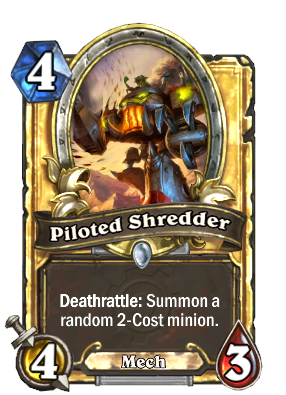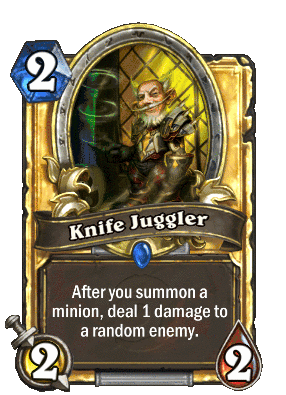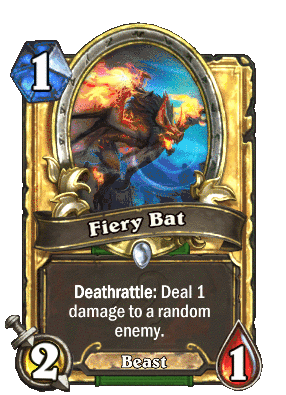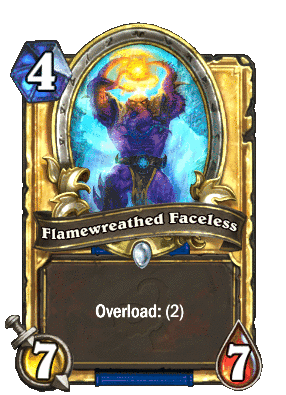After playing the new Hearthstone expansion for about a week, I can say one thing: the game’s changed, a lot. You can see this in two different ways: the loss of some cards and the nerfs to other “evergreen” card selection, or simply the influx of a new card pool made for a very exciting, fresh feel to the first week of the game. That’s pretty telling of the cycle of collectible card games like Hearthstone, but it also demonstrates the necessity to eventually rotate cards out of the game. If you keep every card, eventually tons of broken combinations will be found, and Hearthstone experienced that very problem incredibly quickly.

The first two expansions, Curse of Naxxramas and Goblins vs. Gnomes, really showed a video game developer finding its footing with a card game format; even in the Classic card sets, there’s some really, REALLY overpowered and meta-defining cards, but Naxxramas takes the cake for its staple cards. Haunted Creeper, Mad Scientist, Zombie Chow, Sludge Belcher, Death’s Bite, and Loatheb appeared in pretty much every deck since their introduction, while niche cards like Deathlord, Void Caller, Avenge, and Shade of Naxxramas had their turn in the limelight. These cards dominated the game for so long because they were so good, and not putting them in meant you wanted to lose.
Then, simply add a few cards from Goblins vs. Gnomes (do I even need to mention Dr. Boom or Piloted Shredder?), and the game became incredibly stagnant, fast. Nothing Blizzard introduced was going to best these card designs, not only for their strength but their randomness which often decided games (a random 4/4 from a 4/3 for 4 mana is just not good design, or a 7/7 that summons 2 1/1s that can cause 1-4 damage to random targets). Some of them simply allowed for silly games, like Antique Healbot’s ubiquitous presence in every control deck, or Implosion’s synergy with Knife Juggler that also decided games.

Having every card also meant optimization became a problem, with Paladin eventually attaining an (unintended) perfect curve in the form of Secret Paladin, which was 30% of the ranked ladder players at one estimate before Whispers of the Old Gods. Some classes became stagnant, like Druid’s utter reliance on Force of Nature + Savage Roar combos to end games; further, Druid cards were always the same cards, because there remained no reason to really switch. It simply wasn’t a good situation for players or the developers: things became repetitive and way too optimized on the one hand, and on the other it restricted any future design space to actually make for an exciting new set of mechanics. As a minion-based game, you want people to play new stuff, and we weren’t doing it because it made no sense to put inferior minions into the set.
So, how do you fix this? You get rid of a bunch of card sets, and you nerf some other cards so that no one will ever play them again. That’s a harsh way of phrasing it, but it’s accurate enough! Thing is, it’s difficult to predict the effect of a card before it comes out, and the effect of that card when other cards/interactions that you’ve never even imagined appear out of the blue. Wizards of the Coast discovered this with Magic the Gathering, and so too did Blizzard with Hearthstone. So, if you simply create “formats”, which restrict the card pool, you’re at a big advantage in the design game; you get to figure out which cards are bad, and never make them again, while introducing new, much more fair cards to take their place.

The new card designs follow this ethos for the most part, from my experience. There seems like a clear effort to move away from “optimal” minions to something more like “interesting” minions for each class. It mostly depends on your archetype, especially. Every class has a potentially fantastic low drop now, each with a unique benefit to the class they’re in. Rogues can get a 2/3 if they can combo; Warriors get a 1/1 who gives you a 1/3 weapon. There’s a lot of them like this, but they force some careful decision-making for deck construction and mana curves. If anything, the only problem is that Knife Juggler remains powerful even at 2/2 instead of 3/2, so most aggro decks will probably go for the option of free damage.
Big minions that are slow can now actually exist, since Big Game Hunter became so expensive! C’Thun, rightfully, dominates the metagame since so many cards interact positively with it, but that’s not your only option for end-game victory. Yogg-Saron’s crazy random spellcasts can make or break some games, and N’Zoth’s ability to revives tons of Deathrattle minions is the stuff of new archetypes (hello N’Zoth Paladins and Rogues!). Even Y’Shaarj could be useful, provided you build a deck around him. Each of the 10-mana minions requires setup and planning, which was not true of so many late-game strategies which dominated before Whispers of the Old Gods.
 Of course, things are not entirely perfect. For now, Aggro Shaman dominates the ladder, and for good reason: the deck lost nothing in the translation to Standard, and gained Flamewreathed Faceless with Eternal Sentinel to match, both of which together provide an unparalleled set of turns for unbelievable tempo. Whoever in Blizzard though a 4 mana 7/7 with Overload (2) is somehow correct needs to be given a talk or two, because I honestly cannot understand how a card like this makes it through testing onto an unsuspecting public. Of course, it’s not unbeatable, but it can be overwhelming at turn 5/6 to see your opponent with such a big board with no reasonable means to deal with it.
Of course, things are not entirely perfect. For now, Aggro Shaman dominates the ladder, and for good reason: the deck lost nothing in the translation to Standard, and gained Flamewreathed Faceless with Eternal Sentinel to match, both of which together provide an unparalleled set of turns for unbelievable tempo. Whoever in Blizzard though a 4 mana 7/7 with Overload (2) is somehow correct needs to be given a talk or two, because I honestly cannot understand how a card like this makes it through testing onto an unsuspecting public. Of course, it’s not unbeatable, but it can be overwhelming at turn 5/6 to see your opponent with such a big board with no reasonable means to deal with it.
But, it’s Blizzard, so I expect a stupid mistake or two. They’ve been trying to fix Shaman forever, and apparently they went a little overboard – at least they care! All in all, Whispers of the Old Gods freshens a stagnant game for the first time since, well, forever. It’s a little too early to tell, of course, but I’m hopeful the game remains a little Wild (HA HA) for a bit until people figure out what’s actually competitive. I’ve played a lot of people, and I’ve run into a gamut of different decks with wildly different card lists, so it’s been exciting and fun to see new stuff.
It can take a change to see something a little differently, but they don’t need to be incredibly radical changes. Rather, new experiences and new skills often come to the fore more than you realize, and you can see things anew. It’s sorta like when I do Bible reading – honestly, every time I go through the Bible, I feel like I’m reading an entirely different book. This time around, I’m doing it in the straight order they list the books, and it certainly feels very different than simply picking a book at random and reading it. Now, of course, that’s not really how people are supposed to read it, but it does connect events and parts of the overarching themes much better than reading them in exclusion to each other.
I didn’t realize that Hebrews read so much like a course on apologetics – well, it sorta feels like the first such letter ever crafted. Just for example, in Hebrews 4:
14 Therefore, since we have a great high priest who has passed through the heavens, Jesus the Son of God, let us hold fast our confession. 15 For we do not have a high priest who cannot sympathize with our weaknesses, but One who has been tempted in all things as we are, yet without sin. 16 Therefore let us draw near with confidence to the throne of grace, so that we may receive mercy and find grace to help in time of need.
Verse 15 in particular struck me – why is it important that Jesus experienced temptation of sin without succumbing to it? Obviously, these answers swirled around for thousands of years, but it was important enough that the author of Hebrews advocated for it? The reason why isn’t 100% obvious, at least in my mind. It just takes little things to get me thinking again, even a new translation of a well-worn verse, or reading the context behind a piece of over-quoted Scripture. There’s a ton of depth there you wouldn’t see otherwise.
So yes, this isn’t a new perspective, but sometimes a different approach does wonders to keep things fresh, interesting, and intriguing! That goes for CCGs, and it certainly goes for the Bible too.
